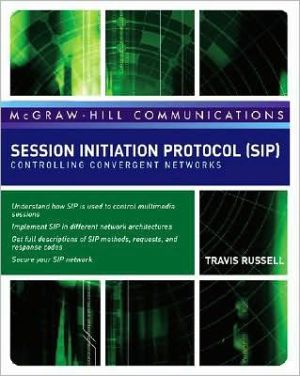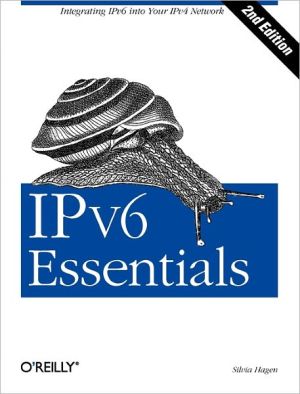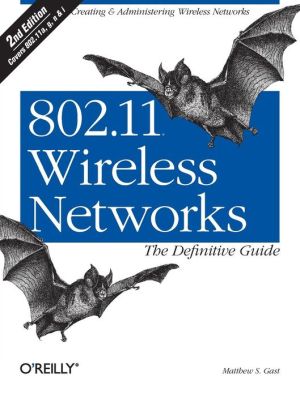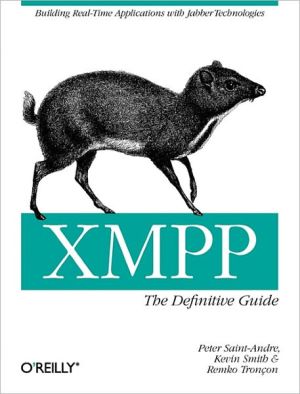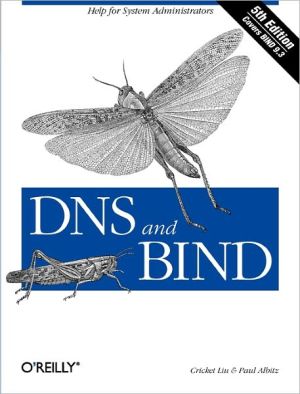Session Initiation Protocol (SIP): Controlling Convergent Networks
Build a next-generation telecommunications infrastructure\ Consolidate divergent networks into one seamless, high-performance communications landscape using cutting-edge SIP technology, tools, and techniques. Session Initiation Protocol (SIP): Controlling Convergent Networks explains how to deliver Internet phone calls, IMs, video streams, and teleconferences across legacy, wireless, and wireline networks. Learn how to manage SIP sessions, build layers and proxies, interpret control codes,...
Search in google:
Build a next-generation telecommunications infrastructureConsolidate divergent networks into one seamless, high-performance communications landscape using cutting-edge SIP technology, tools, and techniques. Session Initiation Protocol (SIP): Controlling Convergent Networks explains how to deliver Internet phone calls, IMs, video streams, and teleconferences across legacy, wireless, and wireline networks. Learn how to manage SIP sessions, build layers and proxies, interpret control codes, set up gateways, and comply with IETF and 3GPP standards. You'll also get details on using the latest methods, maximizing QoS, and implementing security measures. Initiate, modify, and terminate IETF-compliant SIP sessionsConstruct SIP messages, requests, proxies, functions, and layersInterconnect WiFi, WiMax, VoIP, and wireline networksIncorporate TDM and SS7 systems using media and signaling gatewaysDetermine user locations with REGISTER and presence techniquesAugment functionality using RFCs and packet cable extensionsPrevent hijacking, tampering, DoS, DDoS, and BOTS attacksImplement reliable authentication, encryption, and intrusion detection policiesTravis Russell is a senior manager at Tekelec with more than 25 years of experience in data and voice networks. He has numerous patents and patents pending, and is the author of several books including Signaling System #7 and The IP Multimedia Subsystem (IMS).
Acknowledgments xiiiIntroduction xvArchitecture of a SIP Network 1The Traditional Voice Network 2Wireline Network Architecture 2Wireless Network Architecture 5Network Elements in a Voice over IP Network 7Media Gateway (MG) 9Media Gateway Control Function (MGCF) 10Signaling Gateway 10Application Servers (ASs) 11The Domain Name System (DNS) 11Electronic Numbering (ENUM) 12SIP-Specific Entities 13User Agents (UAs) 14Proxy Servers 16Redirect Servers 18Registrars 19Location Servers 19Structure of the SIP Protocol 21SIP Messages and Formats 21Concept of a Dialog 23Requests 25Responses 26Header Fields 28SIP Identities 42Private User Identity 44Public User Identity 45Session Description Protocol (SDP) 46Session Descriptions 48Time Descriptions 50Media Descriptions 51Attributes 52SIP Status Codes 551xx Provisional Codes 572xx Successful Status Codes 593xx Redirection Status Codes 604xx Client Failure Status Codes 615xx Server Failure Status Codes 696xx Global Failure Status Codes 70Registration Procedures in a SIP Network 73Basic Registration 74Event Notification 77Message Waiting Indication (MWI) 77Interworking with the PSTN 79Establishing a Session in SIP 91Accessing the Network 92Initiating a Dialog 93Client Request 97Server Response 99Emergency Session Establishment 101SIP Routing 102Loose Routing 103Strict Routing 108SIP Session Modification 111SIP Session Termination 112Extending SIP to Support New Functions 115The Concept of SIP Extensions 116How Extensions are Documented 117How Extensions are Treated 117Some Examples of Extensions 118P-Access-Network-Info 119P-Answer-State 120P-Asserted-Identity 121P-Associated-URI 121P-Called-Party-ID 122P-Charging-Function-Addresses 122P-Charging-Vector 123P-Early Media 124P-Media-Authorization 125P-Preferred-Identity 125P-Profile-Key 126P-User-Database 126P-Visited-Network-ID Header 127Packet Cable Extensions 128P-DCS-Trace-Party-ID 128P-DCS-OSPS 128P-DCS-Billing-Info 129P-DCS-LAES 130P-DCS-Redirect 131Security in a SIP Network 133Types of Network Attacks 134Registration Hijacking 135Session Hijacking 136Impersonating a Server 137Tampering with Message Bodies 138Tearing Down Sessions 138Denial of Service and Amplification 139Bots and DDoS Attacks 140Security Measures 141Password and Access Controls 145Encryption 146Authentication and Authorization 149Strict Routing 150Security Solutions 151Intrusion Detection 152Intrusion Protection 156SIP-Related RFCs 159IETF SIP Requests for Comments (RFCs) 159Methods and Parameters 163ACK Method 164BYE Method 165CANCEL Method 170INVITE Method 172MESSAGE Method 178NOTIFY Method 182OPTIONS Method 186REGISTER Method 191SUBSCRIBE Method 196UPDATE Method 201Methods and Parameters from a Proxy Perspective 207ACK Method 208BYE Method 209CANCEL Method 213INVITE Method 215MESSAGE Method 220NOTIFY Method 224OPTIONS Method 229REGISTER Method 233SUBSCRIBE Method 238UPDATE Method 243Bibliography 247Index 251
